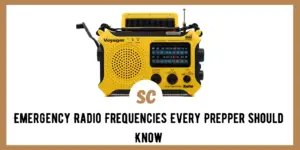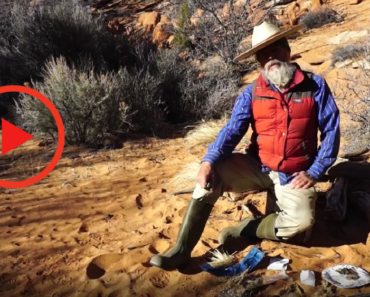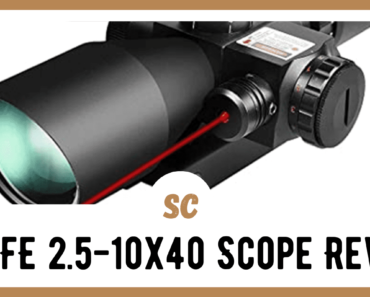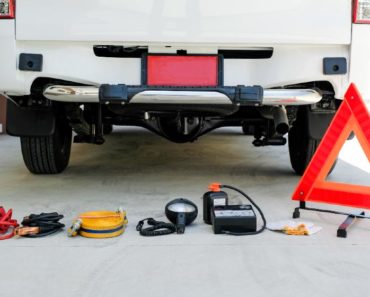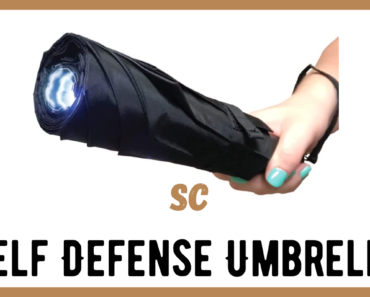I usually spend a good deal of time teaching situational awareness to aspiring survivalists and preppers. Most are cognizant of the need to be tuned in to the surrounding area and what is happening in you operating radius. What many don’t understand is the need to stay situationally aware of conditions in a larger sense.
We all understand the need for situational awareness in almost any situation from walking across a dimly light parking lot at night to being in the wilderness. Heads up and neck on a swivel are watch words to heed. However, in disaster situations, gaining situational awareness on a larger scale involves being able to communicate with entities outside your local operating area.
This usually involves the ability to monitor various sources of information usually broadcast over the air waves via shortwave or HAM radio frequencies. There are two key issues that must be addressed to be successful at this. You must have the proper radio equipment and you must know where to listen for the best information.
In this article, we’ll look at:
- The equipment you need
- Important emergency radio frequencies
- How to get in contact with others in an emergency
Start With the Basics
For emergency communications, the best place to start is with the most well-known means of radio communications. Every community in the U.S. is served by AM and FM commercial broadcast stations. During emergencies, these stations can be invaluable in gathering good information about conditions and situations.
All licensed AM and FM radio stations are required to participate in the Emergency Alert System. This system is managed by the Federal Emergency Management Agency and is designed to deliver reliable and dependable emergency communications using standard broadcast facilities.
Equipment and Frequency Selection
Your emergency kit should have a small portable radio capable of receiving both AM and FM broadcasts. While these radios do not allow two way communications, the ability to receive information about local conditions and situations will be instrumental in assessing current disaster situations.
For example, a portable solar and crank powered AM/FM radio like the one below allows you to access the Emergency frequencies and NOAA weather radio service anywhere and anytime.
Select several known radio station frequencies in both the AM and FM bands to monitor. Typically, the same message will be broadcast by multiple stations using the Emergency Alert System.
Shortwave Receiving
Listening to shortwave broadcasts is both an enjoyable hobby and a great way to get up to date information from radio broadcasters from thousands of miles away. Typically, shortwave broadcasts occur between 1700 KHz and 30 MHz. For many years governments across the world and many private organizations operated high power shortwave stations. The popularity of the internet and social media has led to many of these stations to scale back their operations.
Equipment and Frequencies
100 years ago, shortwave receiving sets were large, bulky affairs requiring expensive tubes to work. Technology advances in electronics have brought the size and cost of shortwave receiving radios down considerably. You can purchase a small, portable shortwave receiver that will cover all of the frequencies for a minimal investment.
These shortwave receivers will allow you to monitor the frequencies normally used by the big shortwave broadcasters as well as scan the frequencies for amateur radio operators that are communicating. This can be an awesome way to gather information on events happening around the world.
Some of the best shortwave broadcast stations to monitor for up-to-date information are included on this list:
- HCJB Deutsch – Frequency 3.995
- BBC – Frequency 6.005
- Vatican Radio – Frequency 9.64
- Radio Free Asia – Frequency 17.64
- Bit Express – Frequency 15.785
There are literally hundreds of amateur radio networks that meet frequently on the air to pass information, messages, and keep each other in touch. My monitoring these regular networks, you can gather intelligence about regional happenings from these radio operators.
Moving Up to Two Way Communications
In a world where we enjoy instant two way communications via our cell phones, the thought of being out of touch with our family and friends is a frightening concept. A disaster situation can play havoc with our usual methods of communications. Preparing a backup plan to communicate involves some sort of two way battery powered radio that can receive and transmit. There are several options to consider when planning for this eventuality.
The Most Basic Two Way Communications
Almost everyone is familiar with the term “walkie talkie.” In the amateur radio world, these small handheld devices are commonly referred to as handy-talkies or just handhelds. Over time, these devices have evolved from the size of a loaf of bread to compact equipment that barely cover the palm of your hand.
Most handheld two way radios utilize frequencies that make long distance communications impossible. In general, these devices work at ranges from one-half to five miles depending on the terrain and conditions. These radios operate on channels that are assigned to a specific frequency.
Emergency organizations don’t use these relatively inexpensive and low power devices. These types of radios are effective for short range contact among family or friends but really aren’t effective for emergency radio frequencies.
GMRS (General Mobile Radio Service)
Newer models of handheld radios being sold in many big box outdoor stores now include the GMRS channels as part of their programming. GMRS is almost a transition radio band between the unlicensed radio frequencies such as the Family Radio Services and CB radio.
You are required to have a license to operate on GMRS channels. The license is easy to get, doesn’t require a test, and covers your entire immediate family. You can apply for a GMRS radio using this link.
GMRS radios have slightly better range than other unlicensed handhelds and many local emergency management agencies are now operating GMRS repeaters which greatly improve the coverage of these radios.
GMRS Emergency Channels
If you elect to add GMRS radio capabilities to your emergency kit, these are the need to know channels where you can tune to get information or make emergency contacts during a disaster:
- Channel 20 on your GMRS radio is the nationwide emergency calling channel
- Many locations have repeaters that work with programmable radios. The transmit frequency is 462.675 and the receive frequency should be set to 467.675. The PL tone setting for these repeaters is 141.3
CB Radio and Emergency Radio Frequencies
CB radio was immensely popular years ago but the interest has waned recently. However, CB radios for emergency use are seeing a rebirth of interest. The REACT groups across the US routinely use CB radios for emergency radio communication. REACT (Radio Emergency Associated Communication Teams) have their roots in CB radio. It is no surprise that this group continues to utilize the CB radio frequencies for communications.
In many areas, REACT groups monitor various CB channels. Some provide 24 hour monitoring, others just during the potential for weather related problems. If you choose to use a CB radio, here are some of the CB channels with which you should be familiar:
- Channel 3 – Monitored by members of the Prepper CB Network (AM)
- Channel 4 – TAPRN (The American Preppers Network)
- Channel 9 – Universal CV Emergency REACT Channel
- Channel 36 – Survivalist Network
- Channel 37 – Prepper 37 (USB)
CB can be a viable relatively short range communication option. If you elect to make CB one of your emergency communications backups, make sure that your CB radio does both AM and single side band operations.
HF, VHF, and UHF Emergency Radio Frequencies
If you are serious about your emergency radio communication capabilities for a disaster situation, you should consider moving into the realm of amateur radio. This class of radios require an amateur radio license to operate legally. What you get for the trouble of taking the HAM radio license exam is the ability to communicate over much longer distances. You can also make use of more sophisticated digital messaging systems.
UHF and VHF Emergency Communications
UHF (Ultra High Frequency) and VHF (Very High Frequency) radios are widely used by emergency organizations for intermediate range radio communications. If a repeater system is employed, the range of these radios is virtually unlimited as long as the repeater and its linking system are operational.
UHF and VHF radios require an FCC issued amateur radio license to operate legally. To attain this license, you must make application to the FCC and take an exam. The entry level Technician license gives you operating privileges on both UHF and VHF frequencies.
UHF and VHF Frequencies
Many emergency and relief agencies use VHF and UHF frequencies for local communications. The following is a list of VHF and UHF frequencies commonly used for emergency communications.
- NOAA (National Oceanic and Atmospheric Administration) broadcasts weather information on a 24/7 basis using the following frequencies. This is a reliable way to stay up to date on current weather conditions.
- 162.4
- 162.425
- 162.45
- 162.475
- 162.50
- 162.525
- 162.55
- National Simplex Calling Frequencies
- 144.200
- 432.100
- 146.520
- 446.000
- ARES (Amateur Radio Emergency Service)
- These local HAM club groups use various UHF and VHF frequencies to operate emergency operations. The best way to determine the proper frequencies for your area is to find a local HAM radio club or ARES organization. For more information about ARES click here.
HF Frequencies for Emergency Operations
For long distance communications when the grid and other infrastructure in your area become unviable, an HF radio may be your only solution. A high frequency radio transceiver is capable of sending and receiving messages over thousands of miles. Using an HF radio requires a General or better FCC license to operate legally.
HF Frequencies for Emergency Communications
Technically, all of the frequencies allocated for amateur radio are useable for emergency communications if necessary. There are groups and organizations that routinely practice and train for emergency communications on certain frequencies. Monitoring or even joining one of these on the air sessions is a good way to sharpen your radio skills. Some of these organizations include the following.
- SATERN (Salvation Army team Emergency Radio Network)
- The Salvation Army operates a worldwide network of HAM radio operators and stations to maintain communications. Various frequencies are utilized for these operations. The SATERN International USB V0ice Net operates on 14.325 MHz Mondays, Wednesdays and Fridays at 10:30 EST.
- AmRRON (American Redoubt Radio Operators Network)
- AmRRON is a group of survivalists and preppers who operate a variety of networks at many levels of HAM radio modes. Some of the ARRON nets operate on these frequencies and at these times:
- 20 Meter Net – 1st and 3rd Wednesday 2000Z hours on 14.338 USB
- 40 Meter Net – 1st and 3rd Wednesday 0100Z hours on 7.238 LSB
- 80 Meter Regional Nets – 1st and 3rd Thursdays 2000 local time 3.818 LSB
- AmRRON also hosts sub-regional and local nets. Check on the AmRRON website for more information about sub-regional nets.
- AmRRON is a group of survivalists and preppers who operate a variety of networks at many levels of HAM radio modes. Some of the ARRON nets operate on these frequencies and at these times:
Regional and State Network Frequencies
Finding an HF network that is active in your region or state can be a great starting place for your emergency radio planning. Becoming active with these groups allows you to hone your radio skills, get to know other HAM radio operators, and build your own network of contacts that might be important during a disaster.
- HF NETS
- 3845.0 LSB Gulf Coast West Hurricane
- 3862.5 LSB Mississippi Section Traffic
- 3865.0 LSB Southern Baptist of Texas Convention
- 3873.0 LSB Central Gulf Coast Hurricane
- 3873.0 LSB Louisiana ARES Emergency (night)
- 3873.0 LSB Texas ARES Emergency (night)
- 3873.0 LSB Mississippi ARES Emergency
- 3910.0 LSB Mississippi ARES
- 3910.0 LSB Louisiana Traffic
- 3923.0 LSB Mississippi ARES
- 3925.0 LSB Central Gulf Coast Hurricane
- 3925.0 LSB Louisiana Emergency (altn)
- 3935.0 LSB Central Gulf Coast Hurricane
- 3935.0 LSB Louisiana ARES (health & welfare)
- 3935.0 LSB Texas ARES (health & welfare)
- 3935.0 LSB Mississippi ARES (health & welfare)
- 3935.0 LSB Alabama Emergency
- 3940.0 LSB Southern Florida Emergency
- 3950.0 LSB Northern Florida Emergency
- 3955.0 LSB South Texas Emergency
- 3965.0 LSB Alabama Emergency (altn)
- 3967.0 LSB Gulf Coast (outgoing traffic)
- 3975.0 LSB Texas RACES
- 3993.5 LSB Gulf Coast (health & welfare)
- 3995.0 LSB Gulf Coast Wx
- 7225.0 LSB Central Gulf Coast Hurricane
- 7235.0 LSB Louisiana Emergency
- 7235.0 LSB Central Gulf Coast Hurricane
- 7235.0 LSB Louisiana Emergency
- 7240.0 LSB American Red Cross US Gulf Coast Disaster
- 7240.0 LSB Texas Emergency
- 7243.0 LSB Alabama Emergency
- 7245.0 LSB Southern Louisiana
- 7248.0 LSB Texas RACES
- 7250.0 LSB Texas Emergency
- 7260.0 LSB Southern Baptist of Texas Convention
- 7260.0 LSB Gulf Coast West Hurricane
- 7264.0 LSB Gulf Coast (health & welfare)
- 7265.0 LSB Salvation Army Team Emergency Radio (SATERN) (altn)
- 7268.0 LSB Hurricane Watch Net Night Frequency
- 7273.0 LSB Texas ARES (alt)
- 7280.0 LSB NTS Region 5
- 7280.0 LSB Louisiana Emergency (altn)
- 7283.0 LSB Gulf Coast (outgoing only)
- 7285.0 LSB West Gulf ARES Emergency (day)
- 7285.0 LSB Louisiana ARES Emergency (day)
- 7285.0 LSB Mississippi ARES Emergency
- 7285.0 LSB Texas ARES Emergency (day)
- 7290.0 LSB Central Gulf Coast Hurricane
- 7290.0 LSB Gulf Coast Wx
- 7290.0 LSB Texas ARES (health & welfare)
- 7290.0 LSB Louisiana ARES (health & welfare) (day)
- 7290.0 LSB Texas ARES (health & welfare)
- 7290.0 LSB Mississippi ARES (health & welfare)
- 14260.0 USB Southern Baptist of Texas Convention
- 14265.0 USB Southern Baptist of Texas Convention Shared with SATERN
- 14265.0 USB Salvation Army Team Emergency Radio(SATERN) (health & welfare)
- 14300.0 USB Intercontinental Traffic
- 14300.0 USB Maritime Mobile Service
- 14303.0 USB International Assistance & Traffic
- 14313.0 USB Intercontinental Traffic (altn)
- 14313.0 USB Maritime Mobile Service (altn)
- 14316.0 USB Health & Welfare
- 14320.0 USB Health & Welfare
- 14325.0 USB Hurricane Watch (Amateur-to-National Hurricane Center)
- 14340.0 USB Louisiana (1900)
Resources for More Frequency Information
One of the best things you can do is to become involved with the emergency radio community in your area. This will get you access to the best information about emergency radio frequencies in your area and how they operate. Many cities and towns have an amateur radio readiness group that are aligned with regional or national groups.
ARES (Amateur Radio Emergency Service)
ARES is the emergency communications arm of the American Radio Relay League. You can learn more about ARES, its local organization, how to become a member, and what opportunities are available by visiting this link to their website.
RACES (Radio Amateur Civil Emergency Service)
RACES is no so much an organization as it is a protocol for emergency radio operations and frequencies set forth by the Federal Emergency Management Agency and the FCC. Each state sets up its own RACES organization which is usually managed by a state emergency operations organization. For more information about RACES you can click here.
REACT (Radio Emergency Associated Communications Team)
REACT groups serve their communities by by providing emergency communications and resources in times of disasters or other emergencies. You can learn more about the REACT organization in your area by accessing this website.
CERT (Community Emergency Response Team)
The CERT program identifies, trains volunteers, and responds to local emergencies when requested by the local jurisdiction have authority. Training includes disaster response, preparedness, first aid, and emergency communications. For more information about the CERT program in your area, click this link.
Keeping the Communication Lines Open
Communications are essential in our society. Reliable communications can be even more critical when things go bad. Disaster, whether man-made or weather related can leave us stranded without information or the ability to contact our family and friends.
Pre-planning for these types of situations is critical. It doesn’t matter if you take a HAM radio exam for a license or choose one of the radio frequencies that don’t require licensing. The important thing is that you have a plan and prepare it in advance.


